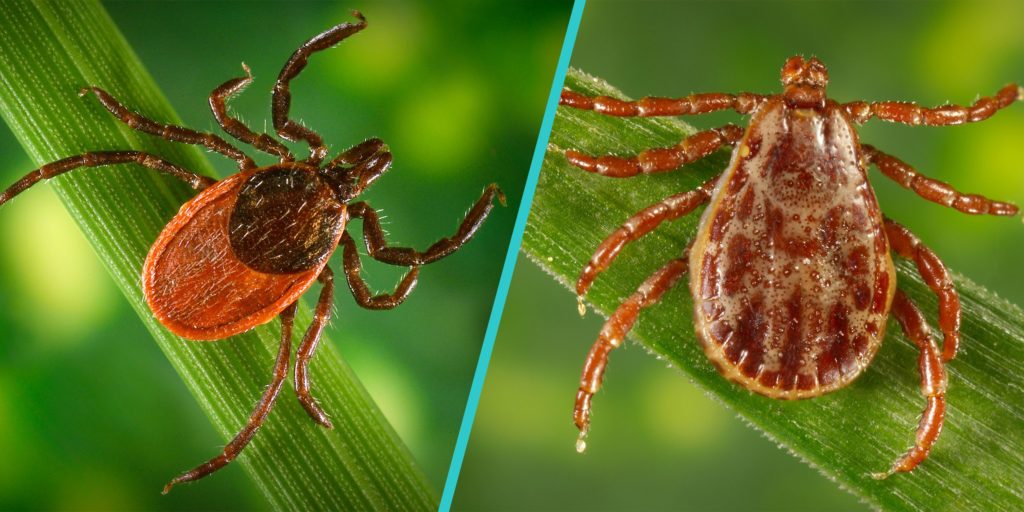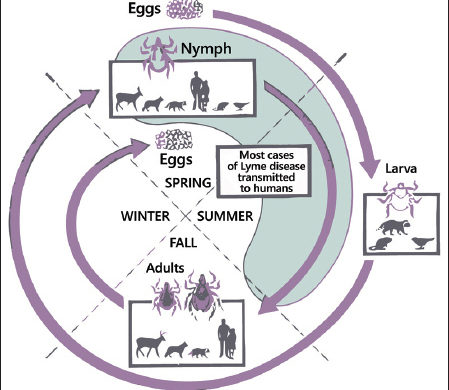
How to Co-exist with Wisconsin’s Ticks
If you plan to be out in the woods or live next to woods, don’t be too quick to trade long pants and long sleeves for shorts and a tee shirt as the weather warms. You need to protect yourself from the ticks that are starting to emerge. Tick bites are possible year-round, but ticks are most active April through September.
Many types of ticks never feed on people. In Wisconsin, the two most common ticks that do are the wood tick, which is not a health concern here, and the black-legged tick (Ixodes scapularis), commonly known as the deer tick, which can transmit several serious diseases including Lyme disease and, more recently, anaplasmosis, which can start with symptoms like fever and nausea and in some cases, progress to organ failure.

Wisconsin is Tick Heaven
The Upper Midwest and the northeastern states are hardest hit by Lyme disease, and the numbers in Wisconsin are rising. According to the Wisconsin Department of Health Services, Wisconsin had 3,105 estimated cases in 2018.
Once considered to be a north woods hazard, deer ticks are now found in every county of the state. Deer are an important blood source for adult ticks, and in 2018 overwinter deer densities in the state varied from three to over 60 per square mile. The abundant woodlands interspersed with agriculture throughout much of central and southwestern Wisconsin creates high quality deer habitat.
“There’s been a change in the past 25 years,” says Dr. Susan Paskewitz, chair of the UW-Madison Department of Entomology. Ticks thrive in moist, shady forested environments, and love our increasingly mild winters. “We find them in pine forests, mixed forests and deciduous forests.”
Paskewitz has sampled along the woody edges and out into the yard in neighborhoods in Eau Claire and near Delton. “Of 90 houses tested, by the end of June, 80 percent of them had at least one deer tick in the area we were sampling. Most were within three to six feet of the woods,” Paskewitz continued, “but a few were found in bright, open, mowed lawn. I don’t think they live long there, but they were making their way out there, so if you are walking out to get your mail without your shoes on, you might pick up that particular tick.”
Paskewitz noted that the two age groups most likely to get Lyme disease are from 60 to 65 and from five to nine. “Kids are outside running in the yard and getting into edge environments more than their parents,” she speculated, adding, “Do a careful tick check on kids.”
Understanding the Deer Tick Life Cycle

Over the course of two years, deer ticks pass through three life stages: larval, nymph, and adult, and at each stage, the tick attaches to a host and consumes a blood meal. In early spring, adult females engorged with blood lay as many as 4,000 eggs. Larvae hatch from the eggs, and after feeding on blood, molt into nymphs, which overwinter, feed again, and grow into adults. Adults feed on a third host, and then mate.
Larval- and nymph-stage ticks can pick up disease-causing pathogens from their hosts and then pass it on to whatever they happen to feed on in their next life stage. The presence of pathogens in the various animals they feed on has a significant impact on Lyme disease risks for people. Both nymphs and adults can transmit disease to humans.
Preventing Tick Bites
Paskewitz and her team spend a lot of time trying to get close to ticks, and they have some advice for the rest of us who want to get out into the woods without becoming a deer tick’s next meal.
- Proper clothing: For Paskewitz, this includes rubber knee boots together with long pants and long sleeves. Those clothes should be impregnated with permethrin. Clothes can be purchased with insecticide in their fibers, but it is less expensive to treat clothes at home. The CDC has a short video that demonstrates how to apply permethrin to clothing, using proper precautions. “Our military and others have incorporated permethrin into uniforms for soldiers who may be crawling around in tick-infested habitats. Once it has dried and bound to the fabric, there are no known health consequences,” says Paskewitz. Note: Wear gloves – Some people develop a mild rash from touching a permethrin solution while it’s wet, and the wet form is also toxic to cats.
- Do a careful tick check every night that you think you may have been exposed. Use a hand-held or full-length mirror and check: under the arms, in and around ears, inside belly button, back of knees, in and around hair, between legs, and around the waist.
- Take a shower as soon as you can and use a sponge, loofa, or other mildly abrasive device.
- Check your clothes. Tumble-drying clothes on high heat for 10 minutes with kill ticks. If clothes are damp, dry them longer. Washing clothes in cold and medium temperature water will not kill ticks.
Consider Downloading the Tick App
Researchers at UW-Madison have developed a smartphone app that is available on the Apple App Store and Google Play Store.
“The Tick App” is an easy way to keep the most important tick-related information right at your fingertips,” says Patrick Liesch, head of the UW-Madison Insect Diagnostic Lab. “It’s a great way for the public to learn about ticks and the appropriate precautions to take during tick season. In addition, the Tick App allows users to contribute to research by completing quick and easy daily logs and is a win-win situation for both the public and the scientific community.”
If You Find a Tick or Tick Bite
The CDC suggests removing an embedded tick asap using a fine-tipped tweezers to grasp the tick as close to the skin surface as possible and pull upward with steady, even pressure. Clean the bite area and your hands with rubbing alcohol, an iodine scrub, or soap and water.
A small bump or redness at the site of a tick bite that occurs immediately and resembles a mosquito bite, is common. This irritation generally goes away in one or two days and is not a sign of Lyme disease.

The classic bullseye rash occurs in 70-80 percent of those infected. It begins at the bite after three to 30 days and expands to 12 inches or more. Fevers, chills, headache, fatigue, muscle and joint aches, and swollen lymph nodes may occur even when there is no rash.
“If you have a tick bite and get a negative test for Lyme disease,” says Paskewitz, “an early test might not read positive because of the nature of the test, but that doesn’t mean you don’t have the disease. Also, we see people get tested for Lyme but not getting tested for the other possible things that are out there now like anaplasmosis, which is pretty common in our state, and babesiosis, which can progress to a form of hemolytic anemia. You have to stay vigilant and be an advocate for yourself.”
Article written by Denise Thornton, Driftless Landowner and Environmental Blogger for digginginthedriftless.com.
